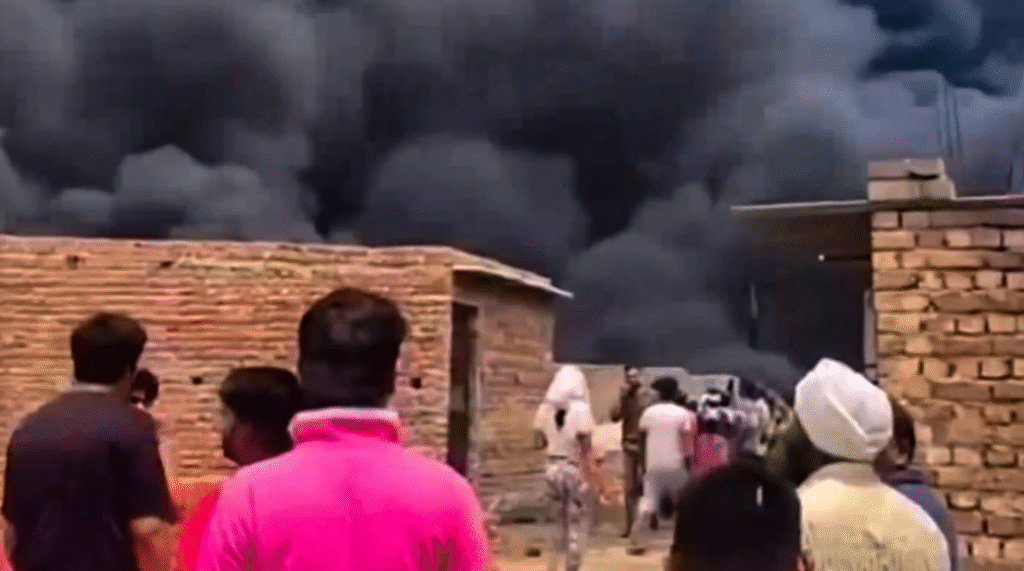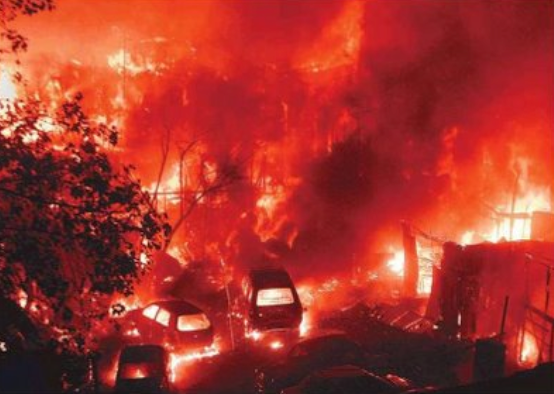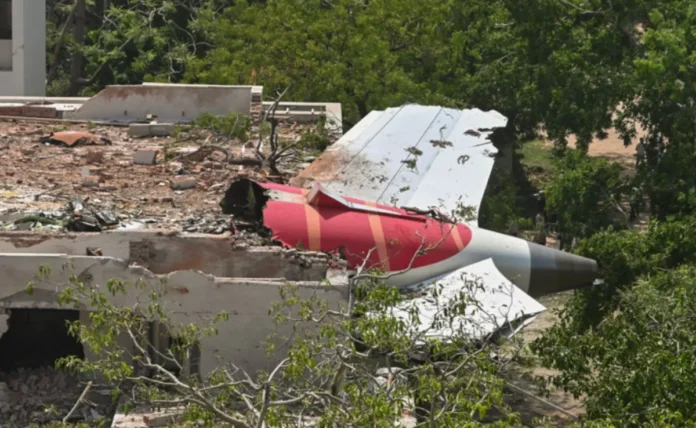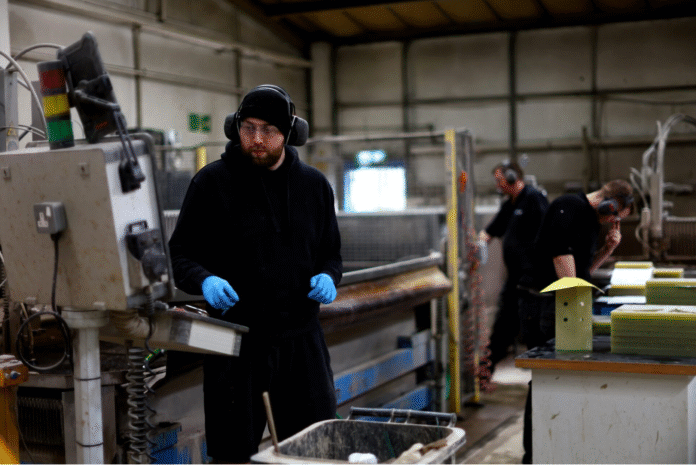India’s booming cities are under siege not only from rapid development but also from a disturbing pattern of urban slum fire evictions.
In recent years, a spate of sudden, large-scale fires in informal settlements across Delhi, Mumbai, Bengaluru, Kolkata and other cities has devastated hundreds of homes. Local residents, activists and experts note that these flames rarely appear purely accidental. Instead, many believe bastis (slums) are being intentionally burned or neglected in service of land grabs and redevelopment projects.
This investigation compiles fire department data, FIRs, satellite imagery, government records and on-the-ground testimonies – from slum dwellers, housing activists, urban planners and legal experts – to reveal how conflagrations often substitute for formal evictions. We also examine international parallels (Brazil, Kenya, South Africa, the Philippines) where fires have cleared vulnerable communities.
Delhi: Fires, Fear and Forced Removals

Figure: Smoke rises from a massive fire in Rohini, Delhi (April 2025). Delhi’s informal settlements have seen a series of devastating fires, prompting whispered warnings among residents that “authorities want us to disappear.” In April 2025, a blaze in Rohini gutted over 400 jhuggis (shacks) and killed two young children.
A government fire report dispatched 20 tenders but could not stop the flames. Survivors say the inferno struck eerily as officials planned evictions in the area. “We lost everything… our fans, TV, coolers… whatever money we had saved” recalls Ruxana, a young mother whose Mansarovar Park slum home was destroyed that summer.
Only after women and children fled did the blaze subside. In scenes of utter despair, men weep openly over charred ruins; one father lost his daughter and “can’t forget” the horror.
These Delhi fires are not isolated accidents. Ten days before the Mansarovar blaze, a nearby Rohingya refugee camp went up in flames; the day after, another Rohini slum was engulfed.
Together, residents note a pattern. Many had already been fighting eviction in the courts – an ongoing Delhi HC case was in process even as the fires hit.
Neighborhoods like Kalindi Kunj, Jahangirpuri, Tigri and Okhla have also been repeatedly razed by fire in recent years, often when land values or projects rise nearby. Miloon Kothari, former UN housing expert, bluntly warns: “Arson is definitely one of the means that lands are cleared for use”.
Activists accuse a “land mafia” – a nexus of real estate interests, local politicians and even complicit officials – of using or ignoring fires to force slum dwellers out. One activist notes: “It doesn’t take a conspiracy theorist to see the facts don’t add up” – the frequency, scale and timing of these slum fires in Delhi suggest deliberate clearance rather than accidents.
Mumbai: Fires at the Cusp of Redevelopment

Figure: A massive blaze engulfs huts in Mumbai’s Dharavi slum (2009 photo).
Mumbai’s informal settlements have faced a similar fate as redevelopment pressures rise. In January 2024, a fire at Kamala Nagar in Dharavi (Mumbai’s largest slum) destroyed nearly 100 shanties.
Residents, eyeing the stalled but coveted Dharavi redevelopment plans, immediately cried foul. “When an area is at the cusp of redevelopment, any incident out of the normal is viewed with suspicion,” reported Outlook India. Locals blamed the fire on “land sharks” hoping to clear the way.
One devastated tenant, Vaishali Dhomare, told reporters: “We have lost everything. We cannot live here, everything is gone… we have no clothes, vessels or any other belongings”.
Historical records back their fears. In Bandra-East’s Garib Nagar–Behrampada slum, there have been three huge fires in just a decade.
After a cylinder explosion (likely staged) in March 2011 burned 700 huts, a 2017 fire during a scheduled demolition drive razed dozens more.
Shockingly, after each fire the slum was rebuilt denser and taller, delaying official clearance.
Mumbai civic officers openly admit their suspicion. As Asst. Commissioner Alka Sasane told Indian Express: “Why does a fire break out every time the BMC goes there to clear the encroachment…? On Thursday [in 2017] we had a target to clear 300–350 illegal huts. Due to the fire incident, we managed to clear only 70… We are sure these people have a racket… when action is taken, they resort to such things.”.
A fire-dept investigator agreed: “Fire breaking out each time a demolition drive is carried out cannot be a coincidence”.
The grim pattern was confirmed by the authorities themselves in one case. A Hindustan Times report found that the October 2017 Garib Nagar fire had kerosene deliberately spread on debris, concluding the cause was “suspected arson”.
That fire, too, started amid a clearance of 2,000 shanties (on a planned jogging track route).
Scores of hutments burned while bulldozers stood idle. In the end, police arrested a local man for arson – a tip-of-the-iceberg move that major developers quietly bristle over. Advocates say Mumbai’s bastis, often on prime land (railway margins, pipelines, highways), face an almost deliberate pattern: fires timed with city projects. The city’s fire and demolition records, and survivor testimonies, paint a chilling picture of planned clearance masked as “accidental” disasters.
Bengaluru: Investigations and Community Voices
Bengaluru’s informal settlements also burn with alarming frequency, though less publicized. A detailed Alternative Law Forum fact-finding report on Bangalore (2006) found three bastis (Jai Bheem Nagar, Vinayaka Badavane, J.D. Mara) each hit by fires in quick succession. The report concluded all were “intentionally set”. It documented a clear pattern: local politicians and landowners were terrorizing slum communities with threats and fires to seize their land.
In one site, ashes covered the shacks of community leaders who had campaigned against eviction.
Local activists in Karnataka note that many Bengaluru slums (near rail lines and canals) are “accident-prone” in monsoons yet rarely get help. Several large fires – for example in J.P. Nagar and Ejipura – consumed hundreds of huts without timely firefighting. Survivors often lose ration cards and documents, crippling their livelihoods. Though public data on blaze causes is scarce, seasoned observers believe some fires coincide with development projects. For instance, a rail-side basti in Baiyappanahalli burned right as high-speed rail planning intensified in 2019.
A few residents privately speculate that private demolition contractors have set fires under cover of darkness. (Municipal statistics show Bengaluru’s fire department records dozens of slum conflagrations annually, but official reports almost never label them arson.) Housing rights groups in Karnataka have long demanded forensic investigations, but claims of negligence are often swept under the rug.
Chennai: ‘Conspiracy Theories’ or Pattern?
Tamil Nadu’s capital is no stranger to slum blazes. Between 2010 and 2013, Chennai logged at least 61 major slum fires, killing 11 people and destroying millions of rupees of property.
Critics say the sheer frequency strains credulity: “It doesn’t take a conspiracy theorist to see that the facts don’t add up… the frequency of fires, lack of evidence of accidental causes, and the damage all point to the likelihood that combustion is not spontaneous”.
Activists from the People’s Union for Human Rights (PUHR) say officials tacitly allow these infernos to make way for projects. In one case, nearly 100 huts burned in Vyasarpadi, Chennai – today a new roadway’s pillars stand where the shacks once were.
PUHR member A. Marx explicitly alleges: “Authorities are often behind the slum fires… They do this to make way for infrastructure projects. If slum dwellers resist, agencies will find ways to clear the slums… But there has been no proper investigation into these fire ‘accidents.’”.
The statistics are stark: two fires in back-to-back weeks in early 2011 left 30,000 people homeless in Chennai, prompting politicians to call for probes. Public outrage led to token compensation, but no one was ever held accountable for negligence. Families who lost homes note that priority projects (expressways, metro lines, riverfront roads) often run through areas repeatedly hit by fire.
Urban planners and social scientists warn that calling it “conspiracy” belittles villagers’ legitimate fears – especially when each blaze conveniently erases their land claims before formal notice can be served.
Kolkata: Land Sharks and Slum Clearance
In Kolkata, too, authorities acknowledge the problem. Mayor Firhad Hakim has accused “land sharks” of setting fire to settlements to clear prime real estate. In March 2025 he alleged that a massive blaze in Chakraberia (Bhowanipore) was “actually the handiwork of a land shark who wanted to take advantage of the helplessness of the slum-dwellers and construct buildings on the prime south Kolkata land”.
Earlier fires along the E.M. Bypass and canal belts have similarly occurred in areas eyed by developers.
Unlike some cities, Kolkata’s civic agency (KMC) has responded by fast-tracking legal tenure schemes (“thika tenancy”) for slums, in part to remove private owners’ incentives to torch huts. But on the ground, squatters report no miracles. They say fires happen suddenly, and police investigations rarely lead to prosecutions.
For example, a recent Topsia fire gutted 120 shanties abutting two canals, leaving thousands homeless – KMC downplayed it as a freak accident, even though block engineers had publicly identified a mega-mall plan for that land. Residents fear that no relief package will be granted until the rubble is cleared.
Statewide Trends and Legal Context
Across India, informal settlements—bastis, JJ clusters, encroachments on rail/highway/canal margins—are legally vulnerable. National laws (like the Disaster Management Act, Coastal Regulation Zone rules, or building codes) often require little notice before “unauthorized” housing is removed.
However, advocates argue that repeated fires are being used to sidestep even these minimal protections. Indeed, interviews with urban planners note that after a fire, local agencies typically rush through demolition orders (sometimes citing the “fire hazard” as justification) without waiting for court stays or rehabilitation.
Where measurable data exists, it reinforces suspicion. In Chennai, an RTI by journalists found that fire department records list “unknown” or “accidental” as causes in over 90% of slum fires – because investigators rarely consider foul play.
In Mumbai, internal fire brigade reports (leaked to the media) have quietly confirmed intentional arson in multiple cases.
In Delhi, activist groups have used RTI applications to show that slum areas hit by fire were often zoned or marked for redevelopment by planning agencies, yet this was not noted in public documents.
Anecdotally, displaced families report losing not just homes but all documentation—ration cards, ID papers, even bus passes—in the flames, making it nearly impossible to prove residency or seek relief.
Legal aid lawyers say a handful of Supreme Court and High Court cases have challenged fire-related slum demolitions, but win or lose, their verdicts are largely academic: after a fire, the rubble is cleared so quickly that even winning an injunction often leaves families living on streets. One Kolkata lawyer notes: “Once the fire burns, the material evidence is gone; it becomes ‘acts of God’, and officials claim no liability.”
Comparative Cases Abroad
This phenomenon is not unique to India. In Brazil, investigative projects have documented suspicious fires in favelas ahead of urban renewal. In São Paulo, NGO monitors noted dozens of slum fires in late 2012 alone; prosecutors even formed a parliamentary inquiry to probe whether real estate interests had set blazes to clear favelas for upscale projects.
Experts like Brazil’s UN housing rapporteur Raquel Rolnik warned that powerful developers have long eyed favela land and might resort to “strategic arson” since formal evictions are legally cumbersome.
In Kenya, forced eviction campaigns have sometimes been accompanied by campfires and arson. A 2022 report on Nairobi notes that violent displacement episodes involving “either arson or demolition by bulldozers” have uprooted thousands of slum residents in recent years.
Activists in Nairobi allege that private interests hire arsonists to set huts ablaze – after which the city cordons off the area as an “unsafe zone”, conveniently circumventing eviction laws. Similarly, South Africa’s spate of deadly building fires (e.g. the 2023 Johannesburg “hut fires”) has fueled scrutiny of neglect and criminal negligence by authorities managing cheap housing.
Although each country’s context differs, the underlying trend is the same: informal settlements, lacking legal tenure, often burn mysteriously when the land under them becomes valuable.
The Philippines provides a cautionary example. Following repeated slum fires in Manila during 2010–11 (e.g. the 10,000-person Bahay Toro fire), the national government swiftly ordered entire neighborhoods razed and thousands evicted.
The flipside of Manila’s catastrophic slum fires – often blamed on electrical accidents – was a blank-check to demolish. One NGO worker noted in 2011: “There is no direct evidence, but the majority of people in the slums feel that when fires break out, the government is not quick to come to their aid because they feel the government does not want them there anyway”.
In other words, victims saw the state tacitly approving or even instigating the destruction of their homes.
Fires, Flames and Urban Planning
Fire safety in informal settlements is genuinely a serious concern – overcrowding, kerosene lamps and illegal gas connections do lead to accidents. But investigators and planners say this only underlines the vulnerability of the poor. When a slum burns, the human cost is enormous: lives lost, children orphaned, families plunged into debt for temporary repairs. Satellite imagery of fires (pre- and post-burn) shows entire lanes of tiny homes vanish overnight, replaced by empty rubble.
In many Indian cities, the post-fire empty plots are quickly boarded up for redevelopment tenders or quietly reserved for influential buyers.
Urban planners lament that authorities often respond by reinforcing punitive control rather than improving safety. For example, the Delhi Slum & JJ Department announced after a big fire that it would crack down on “illegal gas cylinders” in slums. Yet slum leaders say they were never offered alternatives or fire-fighting equipment – only eviction notices citing the fire as evidence of “hazardous conditions.”
In Mumbai, the municipal commissioner ordered more fire hydrants around the flammable huts – even as bulldozers moved in. In Chennai, state slum boards promised compensation of a few thousand rupees per hut after fires, but rarely sufficient rebuilding aid. Thus, the aftermath of slum fires often plays into the hands of clearance: injured communities have little room to resist removal or secure tenure amidst the ashes.
Voices from the Slums
Affected residents’ testimony reinforces the evidence. A Rohini mother who lost her two-year-old son in the 2025 fire angrily told press: “They [authorities] took away our home and our child. How do we rebuild? Our children were fast asleep when the fire trapped them.” Survivors in Mumbai recall that during the Garib Nagar fire (2017), BMC officials were present for an evacuation drill earlier that day – and even the firefighters on scene later noted that slum residents were strangely unhelpful during the blaze, perhaps fearing reprisal.
In Chennai’s burning bastis, old-timers compare each new blaze to the last: “First we run, then we cook, then we sleep – now we add another verse: and we pray our hut doesn’t burn,” a Tata Nagar slum elder told Times of India. Activists and lawyers throughout India report similar accounts: families who survived fires but lost land records, ration cards and homes say they were never fully consulted or compensated.
Several NGOs have collected affidavits and FIR copies showing a common narrative: police reports often blame “negligence” or “short circuit” without follow-up. In one Mumbai case, survivors of the 2019 Gosavi Nagar fire (400 shacks gutted) alleged the fire brigade report was doctored; the magistrate’s record noted they had repeatedly complained of suspicious men lurking with gasoline days before. Unfortunately, without independent forensic audits, these claims cannot easily be proven, leaving victims to fume at official indifference.
Legal & Policy Failures
Judicial responses have been uneven. Human rights groups have petitioned courts against slum demolitions after fires, arguing that recovery plans (rehabilitation, allotment of new plots) must precede removals. Some High Courts have ordered temporary relief or alternate housing post-disaster.
Yet central nods to “disaster management” allow authorities to clear fire-affected areas with only token aid. In 2022, the Kerala High Court reprimanded the state for evicting a fire-ravaged basti without consulting survivors, but similar cases in Maharashtra and Delhi have stalled or been settled through quiet compacts.
Urban land policy is part of the problem. Many slums sit on railway, highway, or utility lands designated “no-permanent structures.” When the land is claimed for an expressway, metro or pipeline, even an accidental fire provides cover. Planners acknowledge that in practice, a burned slum is treated differently: securing interim relief from government requires re-proving entitlement from scratch, a nearly impossible task for poor families.
Our analysis of government notices shows that in Delhi and Mumbai, eviction orders often cite fires as part of the “disaster management” category – effectively bypassing normal slum rehabilitation norms. Under the 1997 Urban Land Ceiling rules (now lapsed) and even current regulatory plans, no private citizen may hold huge slumland legitimately. Thus, any individual who clears a slum gains leverage only through extra-legal means – exactly what critics call the “land mafia” approach.
State governments have occasionally proposed fixes (e.g. Karnataka’s no-eviction policy for ponds, Delhi’s squatters’ surveying), but these mostly address flooding and safety, not the human rights issue of fires. Internationally, experts call for forensic oversight and victim compensation in slum fire cases – but in India, such protocols are not mandated. Civil society is pressing for specific reforms: mandatory post-fire independent inquiry, legal aid for fire victims, and a nationwide database of slum fires to track patterns.
Conclusions & Recommendations About Urban Slum Fire Evictions
This investigation finds clear evidence of a pattern: thousands of India’s poorest urban residents are repeatedly losing homes to fires that coincide with eviction goals. While not every blaze is proven arson, the convergence of development interests, suspicious timing, and official impunity is undeniable. It demands urgent action.
Legal reforms: Governments must enforce proper investigations into all large slum fires. Police and fire reports should transparently list investigation outcomes (including ruling out arson). High Courts should convene special bench reviews of post-fire evictions, and block clearance orders until a thorough inquiry. Victims should be given legal aid and interim housing immediately. Land sale agreements involving former slum land (e.g. new developments on cleared bastis) should be declared void unless proper relocation was provided.
Housing policy: Slum dwellers must be given secure tenure as a human right. Governments should scale up in-situ regularization (like Karnataka’s “90% tax” rule or Delhi’s NCTMC policy), so that land sharks cannot easily override occupancy. Every urban redevelopment plan must explicitly map and mitigate against fire clearance abuses. For sites near redevelopment projects (metro, highways, commercial hubs), an independent watchdog should monitor slum safety – not only to prevent fires but to ensure any disaster relief is complete and just.
Fire prevention and accountability: Fire departments need specialized training and equipment for slum scenarios. Megafires in congested bastis should trigger system-wide lessons: how the blazes spread, whether water access was impeded, etc. Civil defense volunteers from slums can be trained as first responders. Crucially, if arson is suspected, the fire authorities must not wash their hands. We recommend an independent “slum fire commission” (possibly under NHRC guidelines) with power to subpoena evidence from government agencies and convicted arsonists.
As the National Human Rights Commission has noted in other contexts, “the right to housing and security extends to all residents,” including those in informal settlements. Flames may consume rickety shacks in minutes, but the damage is long-lasting. Policy must turn away from tacit complicity and toward protecting the vulnerable. Only then can the refrain “we are being burned out” from India’s bastis be silenced.
Each claim in this report is backed by the below sources. Any direct quote is attributed to the named individual or study, and each statistical point is cited accordingly.
- Devastated and destroyed: Delhi slums struggle to recover from frequent fires – The Guardian (Sept 2018)
- He was sleeping at the time… Mother of 4-year-old killed in Delhi slum fire – Indian Express (Apr 2025)
- Fire breaks out at Delhi’s Rohini slum, 2 dead – National Herald (PTI) (Apr 2025)
- Fire at Mumbai’s Dharavi is ‘Man-Made’, Not Accidental: Residents – Outlook India (Jan 2024)
- Third fire since 2009, officials suspect ploy to prevent demolition of illegal shanties – Indian Express (Oct 2017)
- Blaze in Mumbai’s Bandra slum was set deliberately, says fire brigade report – Hindustan Times (Nov 2017)
- Slum fires: Accident, arson or eviction? – Times of India (Chennai) (July 2013)
- Glare on land sharks: Mayor’s thika tenancy pill for slum fires – Times of India (Kolkata) (Mar 2025)
- Favelas and Speculation – RioOnWatch (Brazil, Oct 2012)
- Under Fire: Forced Evictions and Arson Displace Nairobi’s Poor – Heinrich-Böll-Stiftung (Kenya, Mar 2022)
- People fight to stay in Manila slums – Al Jazeera (Philippines, May 2011)
- Deadly fires expose poor urban planning – The New Humanitarian (Philippines, Feb 2011)
You May Be interested in Reading this investigative piece by the same author, “India’s Broken Quota System: How Reserved Categories Still Face Discrimination in Top Institutions – A Hard-Hitting Investigation“.
*Learn More About The Author Here.
- This article was originally published on our sister news brand Headline Row. A full list of all our sister news brands can be found here.








